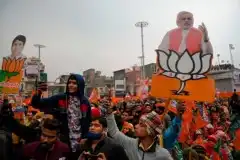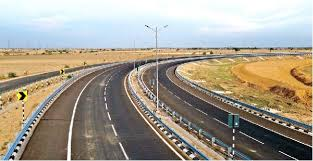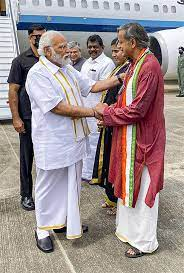Next year or next round of general elections, Indians will weigh PM Narendra Modi's performance and decide whether it warrants making him the second Prime Minister after Nehru to win three consecutive polls.
An overwhelming Indians think, he will !!
 |
| 2013: Grand party was daughter Tanvi's idea !! |
"When a Pakistani video blogger gushes about Indian street vendors offering Paytm QR codes on their tea carts, or bankers rave about India's Unified Payments Interface (which transfers money directly between bank accounts), India gains in global esteem.
The government's claim to have reduced "leakage" by delivering welfare payments directly to beneficiaries' accounts is credible," says Congress lawmaker Shashi Tharoor.
In 2014 Modi had promised 'Achhey Din'. The middle class and English newspapers writing and reading 'intellectuals' may find 20,000 fault lines with that campaign; but for countless 'poor' Indians, once the Modi government took charge, the rate of delivery was high.
The policy slackness of the 1990s were corrected. Officials admitted things were 'democratised' under Modi and even G20 was taken to 50 towns and hamlets across India.
Earlier, officials admit, The FDI inflows since the 1990s were mostly directed towards already affluent and developed hubs such as Mumbai, Delhi, Bangalore, Hyderabad, Chennai and states such as Gujarat.
The allegations of nepotism now appears a thing of past in many states. Modi brought in a new system by taking multiple steps including uniformed tax structure, the GST. And many smaller towns started attracting investment and provided "friendly working and business atmosphere". Red-tapism is slowly being removed.
Prime Minister Modi's push for an infrastructure upgrade to boost the economy has led to an unprecedented 50,000 kilometres of National Highways - the country's arteries - being added in the last 9 years, according to official data, (23-Apr-2023).
"The Modi government can claim some notable accomplishments," admitted Tharoor in an article published in 'The Daily Star' (Dhaka, Bangladesh).
"The most obvious has been the rapid construction of much-needed infrastructure, including new airports, ports, and highways, enabled by streamlined procedures, quick approvals, and extensive reliance on private contractors. The infrastructure boom has changed the face of many parts of India, and the work continues, with large new investments in modernising India's railway network – one of the world's largest, but among its creakiest," says former UN official and a former Union Minister.
The much-vaunted "India Stack" – comprising government-backed application programming interfaces (APIs) – has enabled private companies to build the online commons.
"A startup culture has developed, mainly in the tech domain, and several unicorns (startups valued at more than $1 billion) have emerged..... The Modi government has also overseen progress in the diffusion of technology. The proliferation of smartphones with cheap data plans has connected nearly a billion Indians to the internet".
India's Diwali as a tool of soft power in US
"The White House's recognition of the pan-Indian festival suits Narendra Modi's regime," I reported for UCA News, a globally popular Catholic-run news organisation.
(Photo: Credit AFP/UCAN ---- People watch a laser show on the banks of the River Sarayu during Deepotsav celebrations on the eve of the Hindu festival of Diwali in Ayodhya on Nov 3, 2021)
What else has been happening around?
According to research conducted in 2012 by Stanford University, Indian Americans have/had founded more technology companies than any other immigrant group. Modi sensed the power of Indian diaspora, and hence all these events started in the US, Australia and everywhere else.
Modi will visit Facebook’s Menlo Park headquarters, Googleplex in Santa Clara, and Tesla, the clean energy firm. (visited)
Along with IT superstars like Mark Zuckerberg, founder of Facebook, and Tim Cook of Apple , the vegetarian yoga practitioner will also be seeing Sundar Pichai and Shantanu Narayen and Satya Nadella, the India-born heads of Google, Adobe and Microsoft.
Though India’s IT industry has long been lauded as one of the country’s success stories, the broader challenges of developing the internet around the country remain substantial.
Though there are said to be more than 300 million internet subscribers in India – more than fifth of the population – most connections are patchy and among the slowest in the world. Only a tiny fraction qualify as broadband by industry definitions. A complex web of conflicting commercial interests and bureaucratic obstacles has hindered rapid improvement. Even telephone calls drop repeatedly and are often barely audible, while network congestion means it is impossible to use a smartphone even in parts of the capital, Delhi.
The slow progress at clearing such problems – typical of those that have so far put the brakes Modi’s modernisation drive in other fields – has meant the investment some hoped would come following the landslide election last year has not yet materialised.
“Modi is trying to convince innovators and investors in the US that India is an easier place to invest in but there’s a growing perception that he is all talk and no action on reform. When he was made prime minister, there was tremendous excitement in the [US] community but expectations have not been met, ” said Michael Kugelman, south Asia specialist at the Woodrow Wilson Center in Washington.
All these helped him, and worked for India too.
 |
| Blogger in China: 2019 August |









No comments:
Post a Comment